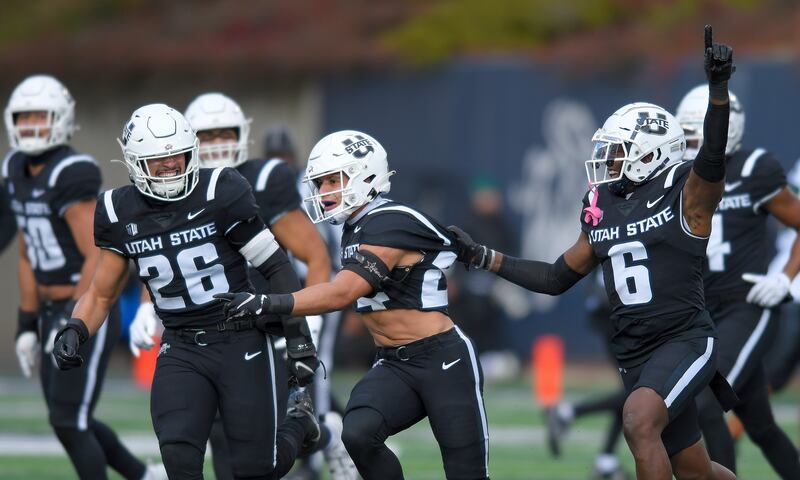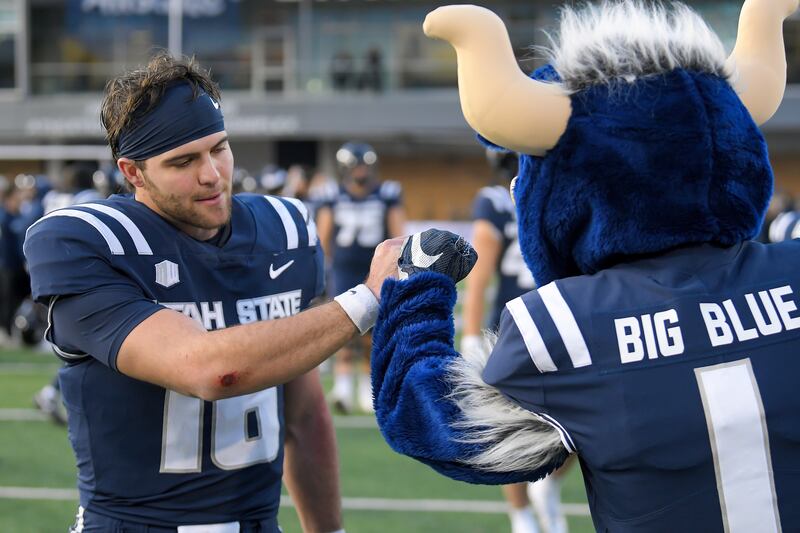Spring football has arrived for the Utah State Aggies.
Starting today, the players begin the process of figuring out who they are and what they have in their first year under new head coach Bronco Mendenhall.
There are plenty of questions about USU right now, what with the Aggies coming off a 4-8 season, a rough campaign that led to an entirely new coaching staff, plus 41 new players.
And spring practices are closed this year to the public, an attempt by Mendenhall to stave off spring transfer portal defections while also hampering opponents' ability to scout the Aggies ahead of the 2025 season.
“After careful consideration, I have reluctantly decided to close our spring practices and not hold a spring game that is open to the public,” Mendenhall said in a statement. “My primary intent is both to protect and retain our current roster and to keep our schemes and strategies unknown from our opponents for as long as possible. I look forward to connecting with Aggie Nation this fall as we wrap up fall camp.”
Many of the questions surrounding Utah State won’t be completely figured out this spring. Some might not even be figured out in the fall.
Utah State will need to figure out some things, though, in order to have the sort of successful campaign — a better than .500 record and bowl eligibility — that it wants in its first season under Mendenhall.
With that in mind, here are four of the most pressing questions for the Aggies entering spring practice.
Did the Aggies do enough to rebuild the defensive front?
Utah State hasn’t been good defensively in awhile.
A long while.
This isn’t the place to go into all the specifics of where the Aggies have failed defensively in recent years, but over the last six seasons, the best Utah State has ranked nationally in total defense was No. 77.
Not so coincidentally, that season (2021) was the year that Utah State won the Mountain West Conference title.
In four of the last six years, USU has ranked No. 103 or lower in total defense, culminating in a dismal ranking of 129 out of 133 total teams last season.
It has proven difficult, if not impossible, for Utah State to overcome such poor defense. There is a reason the Aggies have had one winning record since 2019.
No group is more important to defensive success than the defensive line. It may be boring, but football games are decided in the trenches. Good defenses are born out of good defensive line play. Bad defenses, meanwhile, can be traced back to overwhelmed and out-manned defensive fronts.
Utah State’s defensive front in 2025 will not look much like it did in 2024, roster turnover being the primary reason. Which is probably a good thing.
Gone are players like Cian Slone (defensive end), Blaine Spires (defensive end), Taz Williams (defensive tackle) and Miguel Jackson (defensive tackle), replaced by Tyree Morris (defensive tackle), Antoineo Harris Jr. (defensive tackle) and Kone Aumua-Uiagalelei (defensive tackle), among others.
On paper, Morris, Harris and Aumua-Uiagalelei are intriguing additions. All stand at least 6-foot-2 or taller. They aren’t big, beefy defensive linemen (the heaviest of the group is Aumua-Uiagalelei at 280 pounds) but that is par for the course for Utah State.
The Aggies have, almost never, regularly had 300-plus-pound players on the defensive line. Instead, USU has relied on quick twitch undersized defensive linemen, with the goal being to wreak as much havoc in opponents' backfields as possible. When it has worked, Utah State has had success. When it hasn’t, things have gone bad.
Morris and Harris both are experienced defensive linemen, with time spent at Lafayette and New Mexico.
In theory, their additions should improve USU’s defensive line. And it doesn’t hurt that the Aggies brought back key players like Gabriel Iniguez Jr., Bo Maile and Enoka Migao too.
But have the Aggies added enough up front?
Does Utah State have any stars at linebacker?

A direct byproduct of Utah State fielding leaner and quicker defensive lines has been a heavy reliance on good linebacker play.
Aggie defensive fronts aren’t known for stuffing the run, leaving that task to the linebacking corps more often than not. There is a reason Utah State has had some elite and extremely productive linebackers over the years, most recently players like David Woodward, Justin Rice and MJ Tafisi.
Last year, the Aggies struggled at linebacker, though, due largely to a combination of injuries and inexperience. The season started with Jon Ross Maye and Clyde Washington as the primary linebackers, but both were eventually lost for the season.
That led to significant playing time for players like John Miller, Jadon Pearson and Bronson Olevao Jr.
Miller and Olevao, in particular, showed some flashes and by the end of the year both appeared to be the next in line at linebacker for Utah State.
The reality is, though, one or two solid options (Miller and Olevao) isn’t enough.
Utah State needs real depth at linebacker and some star power, neither of which the team really had in 2024.
The Aggies attempted to correct that with some offseason additions, namely Tymere Burton, Craig McDonald and Brevin Hamblin.
Burton is a former top-10 junior college linebacker, while McDonald previously played at both Auburn and Minnesota, albeit sparingly.
Throw in Hamblin, a Utah Tech transfer and former Syracuse High standout, and Utah State has done a good job adding bodies to its linebackers room. Players that could, maybe even should, see real playing time in 2025.
Is there a star among the group?
It could be Miller, the former Oregon State transfer who finished last season top four on the team in tackles. It could be Burton, who had interest from multiple Power Four teams and scholarship offers from Georgia Southern, Texas State and UTSA, among others.
Finding the next stud Aggie linebacker will go a long way toward some defensive improvement.
Who is going to catch passes from Bryson Barnes or Jacob Conover or Anthony Garcia?

The odds are that Bryson Barnes is going to be Utah State’s starting quarterback in 2025. But if not him, Jacob Conover, Anthony Garcia and even CJ Tiller stand in the wings.
The Aggies are not in a rough spot at quarterback right now, with both experienced veterans and young intriguing talent in the room.
Who the other playmakers on offense will be is a real question, though. At wide receiver especially.
Entering spring camp, Utah State has to replace its top five most productive pass catchers in 2024, with Jalen Royals off to the NFL, Kyrese White with no more eligibility, Otto Tia now at Utah, Grant Page at Southern Miss and Jack Hestera reportedly headed to the transfer portal (per Brian Phillips of Big Blue USU Aggie News).
That group of five players combined for 75% of Utah State’s receiving yards last season and 76% of the Aggies' receiving touchdowns.
Utah State’s passing attack was dynamic last year, no matter who was at quarterback, really, but none of those playmakers are going to be with the team in 2025.
USU did try to rebuild its wide receiver room.
Seven new wide receivers were brought into the fold during the offseason:
- Malakai Alofipo (6-foot-2, 180 pounds)
- Brady Boyd (6-foot-1, 195 pounds)
- Kaleb Mitchell (6-foot-6, 185 pounds)
- Ty Olsen (6-foot-2 190 pounds)
- Braden Pegan (6-foot-4, 200 pounds)
- Demick Starling (6-feet, 195 pounds)
- Corey Thompson Jr. (6-feet, 180 pounds)
None are incredibly proven at the collegiate level.
Boyd, though, came to USU from Texas Tech, Pegan from UCLA, Starling from Western Kentucky and Thompson from UNLV. Those four are the most likely candidates to contribute meaningfully for Utah State from the outset. But again, none is really proven.
Olsen and Mitchell are brimming with potential, but as true freshmen it would appear a long shot that either one becomes a real contributor for the Aggies this year. And Alofipo will be on a mission for The Church of Jesus Christ of Latter-day Saints the next two years.
Utah State very clearly brought in talent during the offseason and returned some pass catching talent as well with Kahanu Davis (wide receiver), Robert Freeman (wide receiver), Broc Lane (tight end) and Josh Sterzer (tight end).
The Aggies need to figure out who exactly will be the playmakers in 2025, though. It can’t all fall on the quarterback.
Can Utah State survive with a smaller roster?
It has been reported and Mendenhall subsequently confirmed in an interview with Cache Valley Daily that Utah State is going to opt in to the House Settlement.
What that means for Utah State football is still something of a question — “I don’t think anyone knows for sure what the true implications of that are going to be,” Mendenhall told Cache Valley Daily — but the House Settlement is going to mean shrinking of rosters, with a cap of 105 per team.
Mendenhall noted that Utah State currently has a roster surplus of 18 players right now and across all of college football — once the House Settlement goes into effect — over 3,000 current college football players will be without a team.
Mendenhall noted that the change will be a real challenge — he also bemoaned the impact the House Settlement will have on walk-ons.
For Utah State, specifically, he noted a difficulty to practice with a smaller roster.
“The fewer roster spots you have, the more difficult it becomes to maintain, manage and keep your roster healthy, because you are practicing with fewer players,” Mendenhall said.
Health, or rather lack thereof, has been a serious issue for Utah State in recent seasons. Last year alone, the Aggies were decimated by injuries on defense.
A smaller roster means USU has fewer available bodies to withstand serious injuries. And for both spring and fall camp, fewer players means actual hitting in practice is a bigger risk than ever before.
Utah State isn’t alone in this, but the Aggies have traditionally been a developmental program, meaning it brings in raw players and over the course of seasons turn them into viable college football players. That task will be harder than ever with less room for prospects on the roster.
Mendenhall has stated multiple times since becoming the head coach at Utah State that he wants to be a developmental program, with an emphasis on in-state players. That task looks like it will be more difficult than ever. And spring camp will offer the first look at what roster management will look like going forward for Utah State.



